Nothing but ice for the last two months and it was driving me crazy. A recent spurt of warm weather had opened up a few tributaries that flowed into a local river,
A half-dozen anglers were sprinkled around near the mouth of a 30-foot wide ditch were it joined the river. They all seemed more concerned with staying warm than fishing, with hands tucked into their pockets and bobbers spewed around in various directions. I found an opening, made a cast that would parallel a fallen tree, and began to slowly work in last years “killer panfish presentation” in a slow stop and go manner. Halfway back the float twitched then went under. A quick hook-set connected me to a fat 11-inch crappie that was quickly landed. My rig picked up right where it left off last year, producing fish under extremely tough conditions where nothing else would work. “Ice-fishing tactics for open water panfish” would best describe the concept.
After the fish was landed I got that “boy is he lucky look” from most of the surrounding anglers. By the third and fourth fish everyone seemed interested in what I was doing. And when I left an hour later with 9 nice-size crappies and nobody else had caught a single fish, they were all thinking that maybe a change in their tactics was in order.
Savvy anglers know that finesse fishing has become increasingly important in today’s angling world. Experienced anglers may use a small jig and minnow to fool wary walleyes, or a 4-inch plastic worm on light line for bass in clear water because fishing pressure has taken a toll, or weather and water conditions aren’t conducive to the fish being active. And trying to catch fish that have been released a few times is also more of a challenge.

While I’ve caught hundreds of fish on this jigging presentation and still use it, there are a few drawbacks to this presentation. It’s tough to fish deeper than 3-4 feet, especially if a stiff breeze is blowing. And it can’t be slowed down to little or no speed unless presented in a vertical manner. Also you really have to whip the rod to get distance when using a super-small jig, which does not allow for much accuracy, something needed when fishing around visible cover.
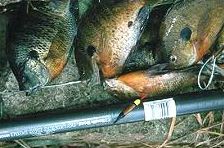

The spoon can be tipped with live bait such as a wax worm, a couple spikes or a sliver of a scented “edible” plastic. In the past I always baited my ice-fishing spoons with live bait, but now if the fish seem to turn on a bit, a sliver of plastic also works very well. Cut the plastic with a razor. This tactic is easier, cheaper, and you can get pretty creative with the baits size, color, shape and how it is put on the hook. A straight piece of plastic will give the lure one type of action, while a piece threaded on in a half-circle will create more side-to-side wobble. Also if bass are a viable option, the length of the plastic can be lengthened to an inch or so. Bulkier, wider cuts can be created to slow down a lures drop speed, a tactic that’s often deadly when dealing with suspended fish.
Various Float Presentations
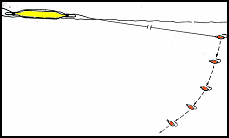
I generally fish this rig with a 6-7 foot panfish rod, but not the “buggy-whip”, soft-action ultra-lights that spray inaccurate casts all over and lack backbone for a good hook-set or to pull a husky panfish away from cover. I like the same action in a panfish rod that most good anglers like in their favorite bass-walleye rods, good backbone for about three-fourths of their length with a fast tip that allows you to make accurate casts and experience good feel.
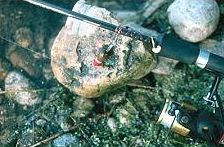

Long Poles
A real fun way to fish float-spoon rigs is with a long lightweight telescopic pole. Being able to gently place the rig next to a clump of flooded grass, reach under a dock, or dabble the spoon into a hard-to-reach wood-lined pocket and pull out fish is a special treat, especially when anglers using standard length rods can’t do it. I always carry several 16-20 foot telescopic poles with me in my truck or boat, and they have saved the day for me on many occasions. And it’s cheap insurance, because poles such as those made by B an M pole company often retail for under 25 dollars.

Flooded banks with inundated grasses or brush are usually best fished with long poles. Walking the banks sends vibrations into the water, and shadows across it. But if you walk softly and carry a long pole and stay 10-15 feet from the edge, you can often catch way more fish than a “conventional” angler. Jiggle the spoon tight to any cover. Lots of early spring fish come out of just a foot or two of water. Try this technique around the edges of man-made ponds. Many ponds have some real monster crappies that anglers rarely catch. These 13-14 inch and larger fish are very vulnerable to this presentation during the pre-spawn, especially if high water floods grassy or weed-lined banks.
Dabbling the spoon into hard-to-reach pockets with the long pole works great. If it’s an extra-tough spot to reach, shorten the line between the rod tip and pole for more control. A problem will arise when you swing a fish out on an 8-foot line that’s attached to a 15-20 foot long pole. The best way to handle this is to bang the vertical-held pole against the ground (or boat floor), to collapse a section or two to reach the fish. Remove the fish, re-extend the pole, and continue fishing.
Constant banging of the pole’s bottom will cause the bottom cap to come off the pole. To prevent this along with pole damage, lash several layers of Duct tape across the bottom cap and up the side about a foot. It’s not pretty but it works. There are numerous ways to use long poles and spoons, these ideas will get you started.
Key Early-Season Spots
Early-to-warm areas are magnets for panfish. On several occasions I’ve slid a small aluminum boat across a large main lake ice flow to reach an open back bay or series of channels that ended up being loaded with fish. This is not a pre-spawn situation, because many fast-warming areas have soft, dark mud bottoms, a condition that’s not favored by spawning fish. The panfish are in these areas to feed. Anything that fits in their mouth is fair game, and plenty of insects and other water critters are available in these warmer areas right after ice-out.
Ideal spots would be shallow, sheltered dark-bottomed areas that receive as much sun as possible. North shores generally receive the most warmth from the south-setting spring sun. Man-made channels, canals, or ditches leading into a lake or river are about as good as it gets. If wind or current blows directly into one of these feeders, the best spots will usually be calm arms that branch off in perpendicular directions. If the canal or channel has at least 3-feet of water going way back into it, don’t be surprised to find fish holding in the calm, back ends.
Cover is an important ingredient to look for. Any wood in a foot or two of water can hold fish and the darker the water the shallower the bluegills and crappies may hold. Flooded grassy or brush-lined banks can be very productive, as can a pier or dock found in the channels, boat harbors, backwaters, or even along a calm, sun-drenched north bank. Wood piers are the best. The support posts suck up the radiant heat from the sun, and even start the food chain, as small fish feed on the moss-covered posts, which in turn draw larger fish. Watch for panfish that suspend along the posts. It’s not uncommon to find panfish a few feet under the surface in 5-10 feet of water. A perfect situation for a slow-falling, fluttering spoon.
Harbors and backwaters are other prime spots to check. Again, calm, sunny, and cover are major factors until the water temperatures climb into the mid 50’s, but the size and direction of the opening that connects the lake to the back bay is also a factor. Narrow openings, especially if they are situated so the main lake flow doesn’t blow through them, are your best bets. Bays with wider-mouthed openings that colder main lake water can easily penetrate offer much less potential.
Just about anything in these bays can hold fish. Stumps, fallen trees, logs, weed clumps, piers, and around marinas are obvious choices. But also check corners full of wind-blown debris (pollen, broken foam coolers, floating boards-just about any junk that supplies some cover), outside of fallen trees or beaver huts for scattered, sunken detached wood, or for suspended, near-surface fish.
Have you ever spooked a bunch of fish in early spring that were hanging near the surface in a calm, sun-struck area? I have many times and either ignored the swirls or made a half-heart cast or two. More likely this was a bunch of big bluegills or crappies that were soaking up some sun. Know what is the best way of catching them? You guessed it-a small ice-fishing spoon below a balsa wood float. Only your imagination will hold you back on ways of using this rig. Try it, you’ll like it!
——————————————————-
For more information about any of the fine Lindy Tackle products mentioned in this article please visit their website at: http://lindyfishingtackle.com.
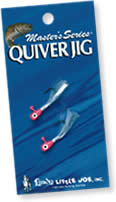
 Monster #2, 2002
Monster #2, 2002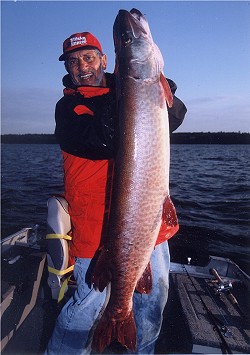 Monster #3, 2003
Monster #3, 2003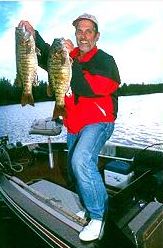


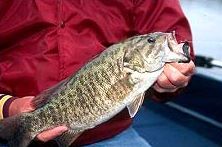
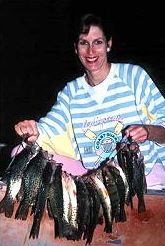

 A jig, dressed with live bait or plain, can be used effectively below a slip float. Because the weight (jig head) and attracter (jig body and/or bait) are at the same point, this set up has certain advantages over a standard weighted live-bait float rig. Every movement of the float, whether caused by waves or angler, activates the jig. You don’t have most of the action absorbed by a weight clamped a foot or two above a hook.
A jig, dressed with live bait or plain, can be used effectively below a slip float. Because the weight (jig head) and attracter (jig body and/or bait) are at the same point, this set up has certain advantages over a standard weighted live-bait float rig. Every movement of the float, whether caused by waves or angler, activates the jig. You don’t have most of the action absorbed by a weight clamped a foot or two above a hook.
 Bodied Wagglers come in lengths up to thirteen inches. This makes them visible in big rough waters, whether your fishing for crappies in a wind-swept reservoir or perch on the big, rolling waters of the Great Lakes. More or less weight can be used to regulate the amount of the float’s stem that’s above the surface. Obviously, more stem above the surface will make float watching easier on a windy day.
Bodied Wagglers come in lengths up to thirteen inches. This makes them visible in big rough waters, whether your fishing for crappies in a wind-swept reservoir or perch on the big, rolling waters of the Great Lakes. More or less weight can be used to regulate the amount of the float’s stem that’s above the surface. Obviously, more stem above the surface will make float watching easier on a windy day.
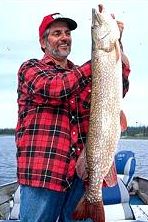
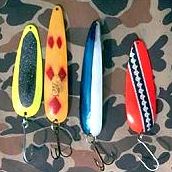 When normally confronted by a big weed bed with lots of potentially good-looking water, trolling usually allows me to quickly check it. I would commonly run bucktails, big spinnerbaits, or shallow-running jerkbaits over the top, and deeper-diving jerkbaits and crankbaits along the edge. Fifteen minutes of trying some of those techniques quickly showed they were a waste of time. Here was the problem. Weed growth was very inconsistent, sometimes it came to the surface, other times it was 3-4 feet below. Lures that ran at a specific, near-surface depth level would constantly foul up in the erratic growth.
When normally confronted by a big weed bed with lots of potentially good-looking water, trolling usually allows me to quickly check it. I would commonly run bucktails, big spinnerbaits, or shallow-running jerkbaits over the top, and deeper-diving jerkbaits and crankbaits along the edge. Fifteen minutes of trying some of those techniques quickly showed they were a waste of time. Here was the problem. Weed growth was very inconsistent, sometimes it came to the surface, other times it was 3-4 feet below. Lures that ran at a specific, near-surface depth level would constantly foul up in the erratic growth.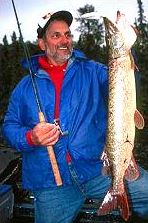
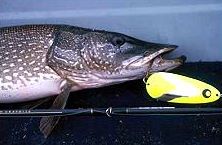
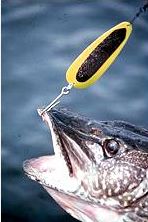 When fishing flutter spoons around weeds, use one with a large single hook, and put the hook on so the point faces the inside or cupped side of the spoon. This rigging will give you the minimum amount of weed snags and make releasing pike easy. With a little practice this single hook spoon can be cast over thick vegetation and skittered across the top, periodically stopping the retrieve so the lure flutters down into holes or along edges. The trick to avoid hanging weeds is to halt the lures flight just before it hits the water by engaging the reel and lifting the rod tip.
When fishing flutter spoons around weeds, use one with a large single hook, and put the hook on so the point faces the inside or cupped side of the spoon. This rigging will give you the minimum amount of weed snags and make releasing pike easy. With a little practice this single hook spoon can be cast over thick vegetation and skittered across the top, periodically stopping the retrieve so the lure flutters down into holes or along edges. The trick to avoid hanging weeds is to halt the lures flight just before it hits the water by engaging the reel and lifting the rod tip. Years ago I would have left clearer and/or shallower lakes during hot, bright days-now I thrive on these conditions!
Years ago I would have left clearer and/or shallower lakes during hot, bright days-now I thrive on these conditions!


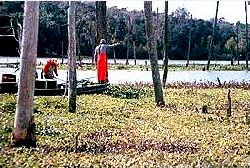 We double anchored about 10 feet from the edge of the floating plants where they formed a deep, open pocket. Daub pulled a long-handled, extra stiff baitcasting rod out of his rod compartment, grabbed a lively shiner out of a bait well, and hooked it underneath, just behind the anal fin.
We double anchored about 10 feet from the edge of the floating plants where they formed a deep, open pocket. Daub pulled a long-handled, extra stiff baitcasting rod out of his rod compartment, grabbed a lively shiner out of a bait well, and hooked it underneath, just behind the anal fin.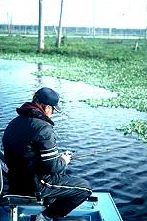
 Walleyes are often found in deeper or fast moving waters, and no lure presentation can be worked with more precision and/or depth control than a big jig. When drifting over a deeper flat area the big jigs will pull your plastic or live bait offering right down to the bottom and keep it there. Then it’s a matter of fine tuning vertical action, drift speed, lure color and what’s put on your jig-plastic or live bait-to achieve maximum results.
Walleyes are often found in deeper or fast moving waters, and no lure presentation can be worked with more precision and/or depth control than a big jig. When drifting over a deeper flat area the big jigs will pull your plastic or live bait offering right down to the bottom and keep it there. Then it’s a matter of fine tuning vertical action, drift speed, lure color and what’s put on your jig-plastic or live bait-to achieve maximum results.

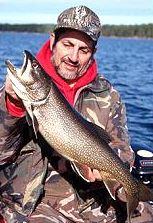 Many fishermen that travel into the north county for pike, walleyes and other species, often find that lake trout are also available. But these anglers often feel ill-equipped to pursue these denizens of the deep because they didn’t bring along any specialized gear for dredging the depths. But there is no need for wire lines, heavy weights, diving planes, downriggers an other cumbersome gear if you toss a handful of jumbo jigs into your tackle box.
Many fishermen that travel into the north county for pike, walleyes and other species, often find that lake trout are also available. But these anglers often feel ill-equipped to pursue these denizens of the deep because they didn’t bring along any specialized gear for dredging the depths. But there is no need for wire lines, heavy weights, diving planes, downriggers an other cumbersome gear if you toss a handful of jumbo jigs into your tackle box.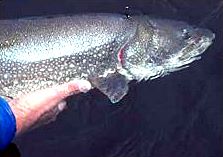 Although the big jigs can be fished effectively on “gutsy”, 6 1/2 to 7 foot spinning rods and 8 to 12-pound test lines, I tend to favor baitcasting gear for most situations. My favorite rod for handling jumbo jigs is either one of the 6 1/2 foot baitcasting rods in South Bend’s “System” series. This rods are the ideal length, have excellent power, great sensitivity and are inexpensive. They also have over 8-inches of handle behind the reel-great for extra relief and leverage when fishing.
Although the big jigs can be fished effectively on “gutsy”, 6 1/2 to 7 foot spinning rods and 8 to 12-pound test lines, I tend to favor baitcasting gear for most situations. My favorite rod for handling jumbo jigs is either one of the 6 1/2 foot baitcasting rods in South Bend’s “System” series. This rods are the ideal length, have excellent power, great sensitivity and are inexpensive. They also have over 8-inches of handle behind the reel-great for extra relief and leverage when fishing.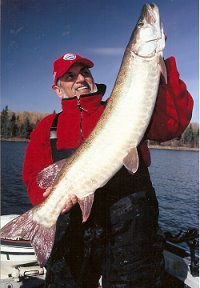 “Here we go again”, I thought as my partner Mike Zielonka put his third musky of the day into the net. Minutes later I finally connected with a nice fish. We were on our annual Lake of the Woods fall musky trip and Mike had seriously “big fished me” the last three years. Each year he has boated at least one fish over 50-inches, culminating with a 55 ½ inch monster in October of 2005.
“Here we go again”, I thought as my partner Mike Zielonka put his third musky of the day into the net. Minutes later I finally connected with a nice fish. We were on our annual Lake of the Woods fall musky trip and Mike had seriously “big fished me” the last three years. Each year he has boated at least one fish over 50-inches, culminating with a 55 ½ inch monster in October of 2005. Day two started slow with me catching the first three fish, all under 37-inches. Then it started! The next was a chunky 44-incher, quickly followed by a 52-incher with the girth of a small barrel. It wasn’t a true 40-pounder, but a good-sized cisco would have put it close. About an hour before dark a 40 ½ incher slammed my Grandma. What a day 6 muskies, including a fat 52-incher.
Day two started slow with me catching the first three fish, all under 37-inches. Then it started! The next was a chunky 44-incher, quickly followed by a 52-incher with the girth of a small barrel. It wasn’t a true 40-pounder, but a good-sized cisco would have put it close. About an hour before dark a 40 ½ incher slammed my Grandma. What a day 6 muskies, including a fat 52-incher.